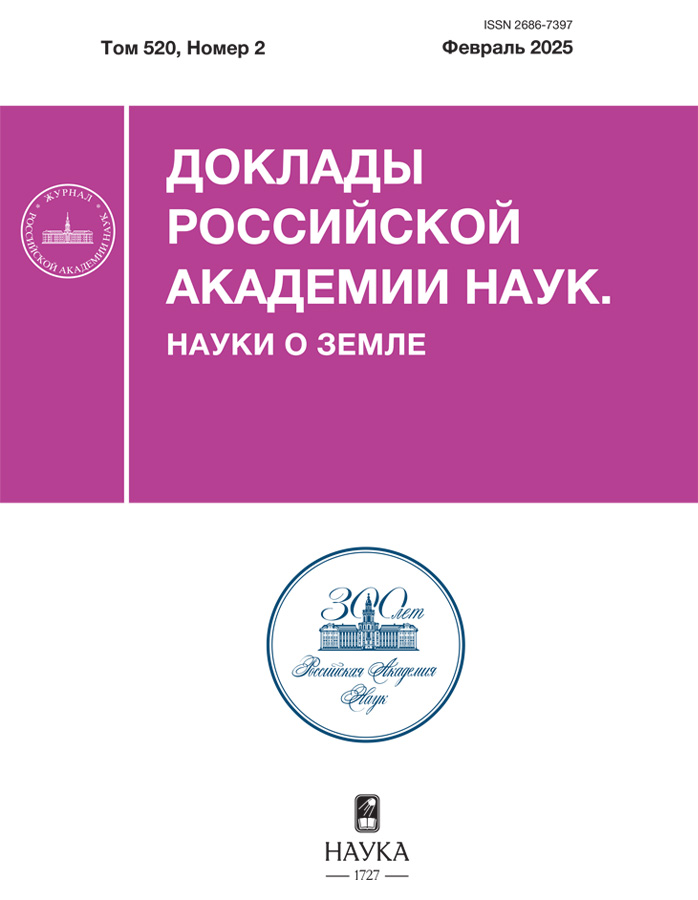Internal sources of CO2 during anatexis under conditions of high-temperature metamorphism (experimental data)
- Autores: Safonov O.G.1,2, Khodorevskaya L.I.1, Kosova S.A.1, Spivak A.V.1, Aranovich L.Y.1,3
-
Afiliações:
- D.S. Korzhinskii Institute of Experimental Mineralogy of the Russian Academy of Sciences
- Lomonosov Moscow State University
- Institute of Geology of Ore Deposits, Petrography, Mineralogy, and Geochemistry, Russian Academy of Sciences
- Edição: Volume 520, Nº 2 (2025)
- Páginas: 271-278
- Seção: PETROLOGY
- ##submission.dateSubmitted##: 19.06.2025
- ##submission.datePublished##: 04.09.2025
- URL: https://rjraap.com/2686-7397/article/view/685148
- DOI: https://doi.org/10.31857/S2686739725020112
- EDN: https://elibrary.ru/GDHUBF
- ID: 685148
Citar
Texto integral
Resumo
Partial melting experiments of garnet-two-mica schist containing 0–20 wt. % graphite were carried out at 900°C and 500 MPa. Experiments have shown that at all graphite contents (within the specified range), metapelite melts are formed by peritectic melting reactions of biotite, muscovite and partly quartz: Bt + Ms + Qz → Kfs + Spl(Hc) + oAm + Sil + Gl. The decreasing Fe3+/(Fe3++Fe2+) ratio in Fe-Mg minerals with increasing graphite content reflects increasing reducing conditions. Oxygen released as a result of the oxidation-reduction reactions of iron reacts with graphite to form CO2. It partially dissolves in the melt to form carbonate complexes of Ca, Mg, K and accompanies it in the form of a free fluid phase. Experiments demonstrate that graphite-bearing metapelites can serve as efficient internal sources of CO2 during high-temperature metamorphism.
Palavras-chave
Texto integral
Sobre autores
O. Safonov
D.S. Korzhinskii Institute of Experimental Mineralogy of the Russian Academy of Sciences; Lomonosov Moscow State University
Autor responsável pela correspondência
Email: khodorevskaya@mail.ru
Rússia, Chernogolovka, Moscow Region; Moscow
L. Khodorevskaya
D.S. Korzhinskii Institute of Experimental Mineralogy of the Russian Academy of Sciences
Email: khodorevskaya@mail.ru
Rússia, Chernogolovka, Moscow Region
S. Kosova
D.S. Korzhinskii Institute of Experimental Mineralogy of the Russian Academy of Sciences
Email: khodorevskaya@mail.ru
Rússia, Chernogolovka, Moscow Region
A. Spivak
D.S. Korzhinskii Institute of Experimental Mineralogy of the Russian Academy of Sciences
Email: khodorevskaya@mail.ru
Rússia, Chernogolovka, Moscow Region
L. Aranovich
D.S. Korzhinskii Institute of Experimental Mineralogy of the Russian Academy of Sciences; Institute of Geology of Ore Deposits, Petrography, Mineralogy, and Geochemistry, Russian Academy of Sciences
Email: khodorevskaya@mail.ru
Academician of the RAS
Rússia, Chernogolovka, Moscow Region; MoscowBibliografia
- Nicoli G., Borghini A., Ferrero S. The carbon budget of crustal reworking during continental collision: Clues from nanorocks and fluid inclusions // Chemical Geology. 2022. V. 608. P. 121025. https://doi.org/10.1016/j.chemgeo.2022.121025
- Cesare B. et al. Immiscibility between carbonic fluids and granitic melts during crustal anatexis: a fluid and melt inclusion study in the enclaves of the Neogene Volcanic Province of SE Spain //Chemical Geology. 2007. V. 237. №. 3–4. P. 433–449. https://doi.org/10.1016/j.chemgeo.2006.07.013
- Whitney D.L. Origin of CO2‐rich fluid inclusions in leucosomes from the Skagit migmatites, North Cascades, Washington, USA // Journal of Metamorphic Geology. 1992. V. 10. P. 715–725.
- London D., VI G.B.M., Acosta-Vigil A. Experimental simulations of anatexis and assimilation involving metapelite and granitic melt // Lithos. 2012. V. 153. P. 292‒307. https://doi.org/10.1016/j.lithos.2012.04.006
- Митяев А.С., Сафонов О.Г., Варламов Д.А., ван Ринен Д. Д., Сердюк А.А., Аранович Л.Я. Частичное плавление бесплагиоклазового гранат-двуслюдяного метапелита как модель образования ультракалиевых кислых магм в условиях континентальной коры // ДАН. 2022. Т. 507. № 2. С. 95–103. https://doi.org/10.31857/S2686739722601703
- Chappell B.W., Bryant C.J., Wyborn D. Peraluminous I-type granites // Lithos. 2012. V. 153. P. 142‒153. https://doi.org/10.1016/j.lithos.2012.07.008
- Frost B.R., Barnes C.G., Collins W.J. et al. A geochemical classification for granitic rocks // Journal of petrology. 2001. V. 42. №. 11. P. 2033‒2048. https://doi.org/10.1093/petrology/42.11.2033
- Koester E., Pawley A.R., Fernandes L.A. et al. Experimental melting of cordierite gneiss and the petrogenesis of syn- transcurrent peraluminous granites Brazil // J. Petrol. 2002. V. 43. P. 1595–1616. https://doi.org/10.1093/petrology/43.8.1595
- Pichavant M., Montel J.M., Richard L.R. Apatite solubility in peraluminous liquids: Experimental data and an extension of the Harrison-Watson model // Geochimica et Cosmochimica Acta. 1992. V. 56. №. 10. С. 3855‒3861. https://doi.org/10.1016/0016-7037(92)90178-L
- McMillan P.F. Water solubility // Rev. Mineral. 1994. V. 30. P. 131–156. https://doi.org/10.1515/9781501509674-010
- McMillan P. Structural studies of silicate glasses and melts—applications and limitations of Raman spectroscopy //American Mineralogist. 1984. V. 69. №. 7–8. P. 622–644.
- Reich S., Thomsen C. Raman spectroscopy of graphite // Philosophical Transactions of the Royal Society of London. Series A: Mathematical, Physical and Engineering Sciences. 2004. V. 362. P. 2271–2288. https://doi.org/10.1098/rsta.2004.1454
- Frezzotti M.L., Tecce F., Casagli A. Raman spectroscopy for fluid inclusion analysis // Journal of Geochemical Exploration. 2012. V. 112. P. 1–20. https://doi.org/10.1016/j.gexplo.2011.09.009
- Wang X. et al. Raman spectroscopic measurements of CO2 density: Experimental calibration with high-pressure optical cell (HPOC) and fused silica capillary capsule (FSCC) with application to fluid inclusion observations // Geochimica et Cosmochimica Acta. 2011. V. 75. № 14. P. 4080‒4093. https://doi.org/10.1016/j.gca.2011.04.028
- Шмулович К.И., Шмонов В.М. Таблицы термодинамических свойств газов и жидкостей. М.: Изд-во стандартов, 1978. № 3.
- Ni H., Keppler H. Carbon in silicate melts // Reviews in Mineralogy and Geochemistry. 2013. V. 75. №. 1. P. 251–287. https://doi.org/10.2138/rmg.2013.75.9
Arquivos suplementares
















